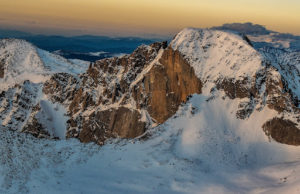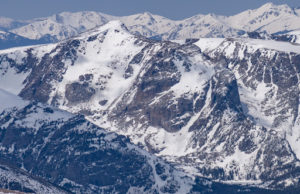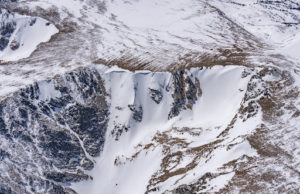Backcountry Skiing Rocky Mountain National Park by Mike Soucy
Massive glaciers carved out the landscape that is now the third most popular National Park in the United States based on visitation. What today is known as Rocky Mountain National Park(RMNP) was first visited by humans 11,000 years ago. Spearheads and scrapers along with other artifacts shed light into this land’s past. Up until the 1700’s RMNP was a summer get-away for the Ute tribe who enjoyed the vast alpine tundras, green valleys, and turquoise lakes. Early Spanish explorers, French fur traders, and the United States Military steered clear of the intimidating mountain range up until 1843 when Rufus Sage wrote down the first accounts of the park. (NPS 2015)
Longs Peak, the guardian of the park and its highest peak reaching 14,255’ catches anyone’s eye whether they be a “ski-bum” or not as they are pulling out of Denver International Airport. The prolific diamond face and flat summit comparable to a football field make Longs one of the most well known peaks in Colorado and Rocky Mountain National Park a go-to destination for many mountain-oriented travelers. Due to its popularity and extreme terrain, more than 70 people made Longs their last climb due to hypothermia, past medical conditions, altitude related injuries, or falling.
- The Diamond-Longs Peak Photo by Alex Buisse
- The Elevator Shaft-Chaos Canyon
- Ptarmigan Fingers-Odesea Gorge
The new RMNP ski atlas, map, and digital guidebook boasts thirteen distinct areas with a total of fifty-five runs. Of the thirteen areas, nine of them are classified as complex terrain that include high angle open terrain, intricate cliffy terrain containing steep couloirs, and/or spines that may have significant overhead hazard.
RMNP contains many classic Colorado ski lines that are outlined in the guidebook. Some of the lines that are outlined in the book are the Y couloir on Ypsilon peak (55 degrees), the Dragontail couloir in the Tyndall Gorge (55 degrees), the Elevator Shaft in Chaos Canyon (55 degrees), the Sky couloir in the Loch Vale (55 degrees), and McHenrys Notch in the Upper Glacier Gorge (55 degrees). If these grades worry you then they should! However, RMNP also contains mellower tours for those who wish to enjoy the view and keep their risk tolerance low such as Fall River South, Upper Hidden Valley, Lower Hidden Valley, and Chaos Canyon.
This past summer of 2022 a change to the Beacon Guidebook products and to the park itself happened at Hallett Peak in Chaos Canyon. A very large debris slide came free off the southside of Hallett Peak. Apartment complex size boulders slid as well as other varying size boulders and the existing snowfield. In some areas the debris ripped all the way down to the bedrock. No injuries or deaths occurred due to the slide. One of the unexpected by-products of the slide is the change in color of Lake Haiyaha from its typical clear alpine lake look to a sea-green from the “rock-flour” transported into the lake after the slide. Chaos Canyon past Lake Haiyaha is closed until further notice because there are still many active slide areas.
What is one part of the avalanche recipe that never changes? Terrain. Terrain is the only constant. With Backcountry Skiing Rocky Mountain National Park and Rakkup’s powerful planning and execution tools, you can read your run the night, week, or month before. Refer to it as you travel through the field, assess your conditions, and adjust your plan as necessary.



